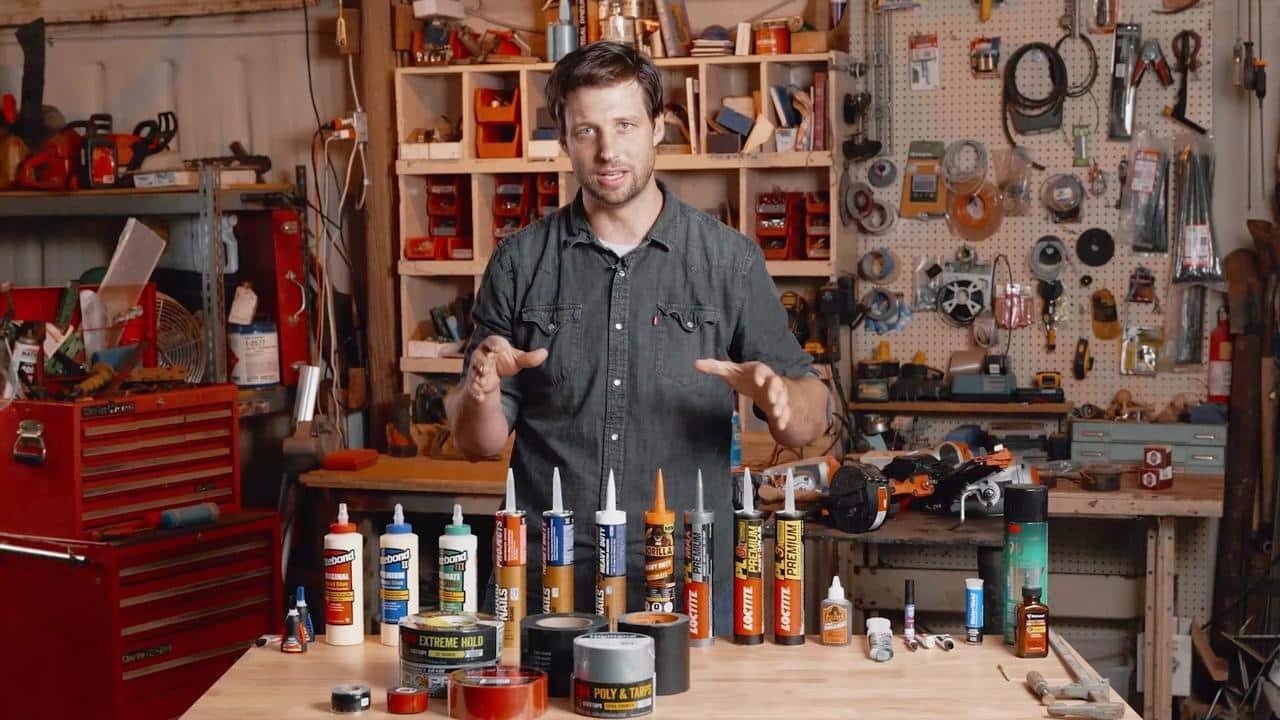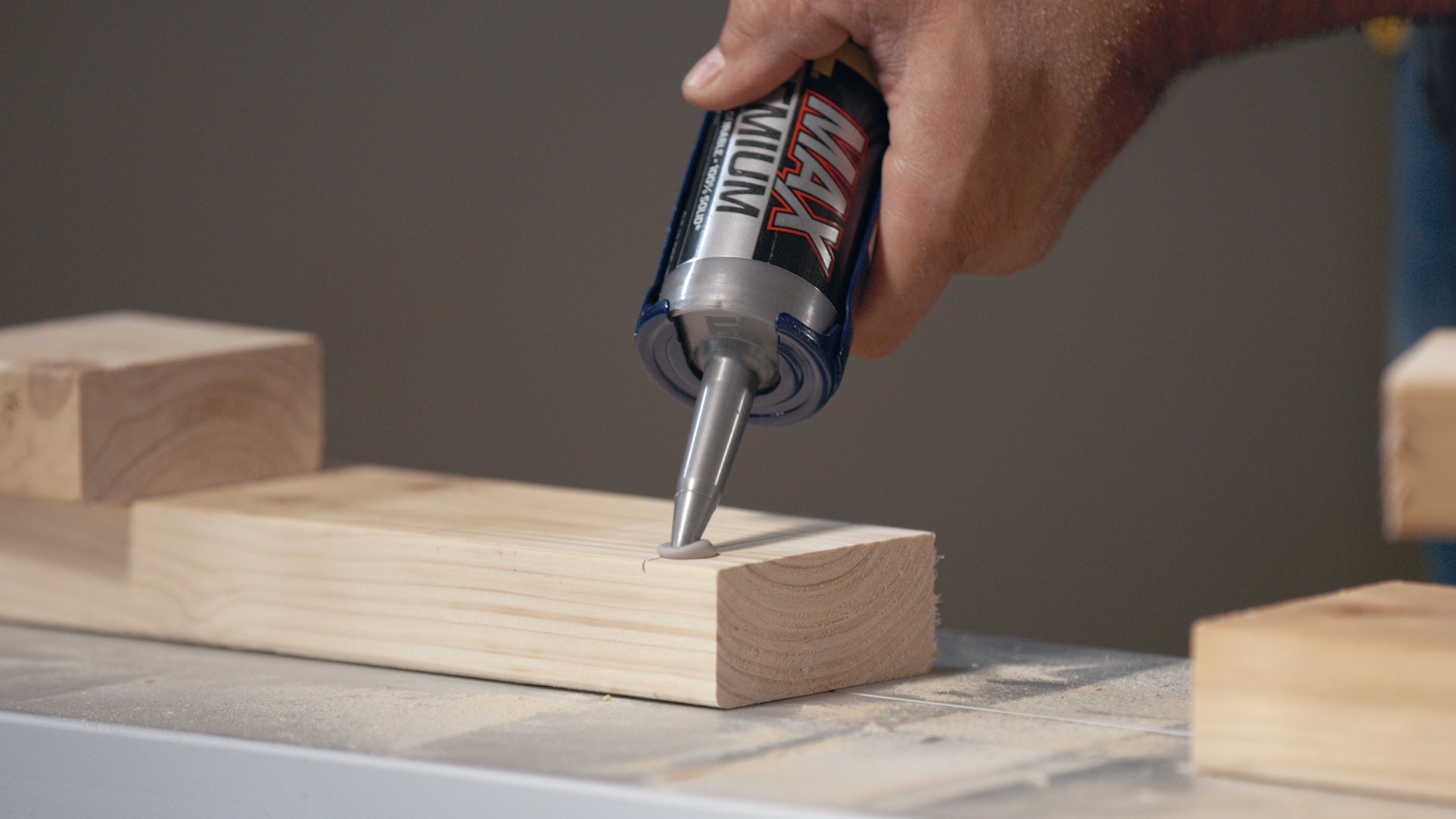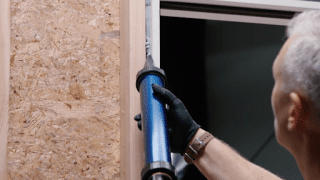
The first adhesives were made by boiling animal hides, hooves, and horns to extract collagen, which was the basis of hide glue. The sticky substance was used in furniture making, book binding, and repairs to pottery and other objects.
Today, most glues are made from polymers, a group of chemical compounds that consist of large molecules with repeating subunits. The molecular structure of polymers give them their toughness and elasticity, making polymers (both natural and manmade ones) ubiquitous in daily life. Wool, rubber, Styrofoam, and epoxy are just a few of the polymers that you likely already know.
Read on to learn about four common types of polymer-based glue.
1. Cyanoacrylate, AKA superglue
Cyanoacrylate is a group of adhesives that form long and strong polymeric chains in the presence of water. If that term isn’t familiar, you may recognize the brand names of the most popular types of cyanoacrylate adhesives—Super Glue and Krazy Glue.
This type of glue is, in fact, super, crazy strong, with tensile strengths reaching up to 4,000 psi (depending on the material it is bonding) and without any of the mess of a two-part epoxy system.
Given its strength and the relative ease of use, you might wonder why its use is limited to small repairs. Cyanoacrylate has proven revolutionary in the areas of industrial, medical, and technological production and yet it doesn’t play a large part in erecting buildings, because it’s not a great structural adhesive.
How does cyanoacrylate work?
Cyanoacrylate’s acryl groups form polymers in the presence of moisture. “Because moisture is so abundant in our atmosphere,” Jordan explains, “when you open Super Glue, it doesn’t take long for moisture to get in there and cure the whole tube.” In other cases, however, you may need to add some moisture. When using cyanoacrylate to join non-porous materials like glass or steel, you may want to lightly mist them before applying the glue.
When to use cyanoacrylate
The main factor in favor of cyanoacrylate is its ease of use compared to some other adhesive options. Super glues are also compatible with most materials, both porous and non-porous. However, there are several downsides to consider: a fast set time, which leaves you with little to no time to position and clamp work; and low ductility—brittle bonds that poorly resist impact loading.
- When you need something easy to use. Unlike two-part epoxies, there is no complicated mixing required. Just squirt a small amount of the glue onto the surface you want to bond with another.
- Projects that call for strong bonds. Its tensile strength is comparable to that of epoxies and polyurethane products.
- When you’re working quickly. In general, no clamping is required with Super Glue. Just hold the two objects you are joining in place for a few minutes and they will be set (though it is best to leave them for 24 hours to cure fully).
- Small projects. Cyanoacrylate is substantially more expensive compared to other glues, so use it for small repairs rather than big projects.
2. PVA (Polyvinyl acetate), AKA white glue or wood glue

It’s likely that the first glue you ever used was a PVA: Elmer’s Glue. Wood glues are a particularly strong PVA.
The ingredient that makes PVAs effective as adhesives is polyvinyl acetate, a rubbery polymer that forms a hard bond as it dries. Among its strengths when it comes to wood (and some other porous materials) is that the glue seeps into the fibers, creating a stronger bond as it hardens.
Whereas cyanoacrylate uses moisture from the atmosphere to cure, PVAs expel moisture to cure. PVAs are a more flexible type of adhesive—meaning they’re less brittle than cyanoacrylate—and they have a longer curing time. The longer curing time gives you more time to work, but it also means that you must be careful not to disturb it while it cures, or the bonds will break.
Available in different colors and varieties (carpenter’s glue is the common name for one with a yellowish hue, and some are designed for outdoor use), there’s a type of wood glue for almost every carpentry project, including indoor and outdoor applications.
You will typically want to clamp a PVA bond for the first 30 minutes to one hour while it sets as the glue dries. It takes 18 to 24 hours to cure completely.
Why don’t structures fall down or come apart? Learn all about the stuff that holds building materials together in the MT Copeland online Fasteners and Adhesives course. Taught by professional builder Jordan Smith, the course covers topics ranging from nails and screws to glues and epoxies.
How strong is wood glue?
Wood glue strength ranges from roughly 3,600 to 4,000 psi—that is they can withstand pressures of between 3,600 and 4,000 pounds per square inch.
The adhesive bonds of wood glues—as well as epoxies and polyurethane adhesives, both of which can also be used to join wood—are stronger than most woods. That means the wood will most likely fail before the bond does.
The first adhesives were made by boiling animal hides, hooves, and horns to extract collagen, which was the basis of hide glue. The sticky substance was used in furniture making, book binding, and repairs to pottery and other objects.
Today, most glues are made from polymers, a group of chemical compounds that consist of large molecules with repeating subunits. The molecular structure of polymers give them their toughness and elasticity, making polymers (both natural and manmade ones) ubiquitous in daily life. Wool, rubber, Styrofoam, and epoxy are just a few of the polymers that you likely already know.
Read on to learn about four common types of polymer-based glue.
1. Cyanoacrylate, AKA superglue
Cyanoacrylate is a group of adhesives that form long and strong polymeric chains in the presence of water. If that term isn’t familiar, you may recognize the brand names of the most popular types of cyanoacrylate adhesives—Super Glue and Krazy Glue.
This type of glue is, in fact, super, crazy strong, with tensile strengths reaching up to 4,000 psi (depending on the material it is bonding) and without any of the mess of a two-part epoxy system.
Given its strength and the relative ease of use, you might wonder why its use is limited to small repairs. Cyanoacrylate has proven revolutionary in the areas of industrial, medical, and technological production and yet it doesn’t play a large part in erecting buildings, because it’s not a great structural adhesive.
How does cyanoacrylate work?
Cyanoacrylate’s acryl groups form polymers in the presence of moisture. “Because moisture is so abundant in our atmosphere,” Jordan explains, “when you open Super Glue, it doesn’t take long for moisture to get in there and cure the whole tube.” In other cases, however, you may need to add some moisture. When using cyanoacrylate to join non-porous materials like glass or steel, you may want to lightly mist them before applying the glue.
When to use cyanoacrylate
The main factor in favor of cyanoacrylate is its ease of use compared to some other adhesive options. Super glues are also compatible with most materials, both porous and non-porous. However, there are several downsides to consider: a fast set time, which leaves you with little to no time to position and clamp work; and low ductility—brittle bonds that poorly resist impact loading.
- When you need something easy to use. Unlike two-part epoxies, there is no complicated mixing required. Just squirt a small amount of the glue onto the surface you want to bond with another.
- Projects that call for strong bonds. Its tensile strength is comparable to that of epoxies and polyurethane products.
- When you’re working quickly. In general, no clamping is required with Super Glue. Just hold the two objects you are joining in place for a few minutes and they will be set (though it is best to leave them for 24 hours to cure fully).
- Small projects. Cyanoacrylate is substantially more expensive compared to other glues, so use it for small repairs rather than big projects.
2. PVA (Polyvinyl acetate), AKA white glue or wood glue

It’s likely that the first glue you ever used was a PVA: Elmer’s Glue. Wood glues are a particularly strong PVA.
The ingredient that makes PVAs effective as adhesives is polyvinyl acetate, a rubbery polymer that forms a hard bond as it dries. Among its strengths when it comes to wood (and some other porous materials) is that the glue seeps into the fibers, creating a stronger bond as it hardens.
Whereas cyanoacrylate uses moisture from the atmosphere to cure, PVAs expel moisture to cure. PVAs are a more flexible type of adhesive—meaning they’re less brittle than cyanoacrylate—and they have a longer curing time. The longer curing time gives you more time to work, but it also means that you must be careful not to disturb it while it cures, or the bonds will break.
Available in different colors and varieties (carpenter’s glue is the common name for one with a yellowish hue, and some are designed for outdoor use), there’s a type of wood glue for almost every carpentry project, including indoor and outdoor applications.
You will typically want to clamp a PVA bond for the first 30 minutes to one hour while it sets as the glue dries. It takes 18 to 24 hours to cure completely.
Why don’t structures fall down or come apart? Learn all about the stuff that holds building materials together in the MT Copeland online Fasteners and Adhesives course. Taught by professional builder Jordan Smith, the course covers topics ranging from nails and screws to glues and epoxies.
How strong is wood glue?
Wood glue strength ranges from roughly 3,600 to 4,000 psi—that is they can withstand pressures of between 3,600 and 4,000 pounds per square inch.
The adhesive bonds of wood glues—as well as epoxies and polyurethane adhesives, both of which can also be used to join wood—are stronger than most woods. That means the wood will most likely fail before the bond does.
When to use PVA wood glue
PVA wood glue is used extensively in furniture, cabinet making, and finish carpentry, and often used in conjunction with a fastener. Fasteners are often used to hold the joint tight as the adhesive cures. The final product will be held together with the strength of the glue, but the nail holds it in place until the glue builds to its final strength.
3. Polyurethane adhesives, AKA general construction adhesives
Polyurethane glue entered the American market until 1994 when the Gorilla Glue company began selling polyurethane glues. (For many Americans, Gorilla Glue is the more familiar name for polyurethane than its chemical one.) Over the last two decades, it has become one of the most common go-to construction adhesives that contractors depend upon for all sorts of jobs. Popular brands include Titebond and Loctite.
Similar to cyanoacrylates, polyurethane adhesives require a chemical reaction in order to cure, and that reaction is set off by moisture.
If you’re gluing concrete to wood, no problem—concrete has moisture; wood’s got moisture. When one of the substances is non-porous, however, some extra moisture is required. Jordan recommends moistening one side of your joint using just a little spritz bottle—then apply glue to the other side and stick them together tight.
See the strength of polyurethane glue in action in Chapter 8, in which Jordan uses it to lift a car.
When to use polyurethane glue
While the application of polyurethane as an adhesive is not especially complicated (though it can be a little messier than some other glues), first you need to know its advantages and disadvantages when compared to wood glue, epoxies, and other options.
- Joining different materials. Polyurethane adhesives are truly multi-purpose products and can be used to bond a variety of building materials: wood, glass, concrete, metals, carpets, and more. If you are bonding two nonporous materials—like metal on metal—just make sure to moisten the surfaces before you glue them.
- Outdoor projects. Polyurethane bonds are waterproof, making it a good adhesive choice for outdoor projects. (Though they will not withstand being submerged for extended periods.)
- When you need to paint. While some ordinary adhesives’ performance will be impaired if they are painted, polyurethane can be painted after it has set.
- When you’re working somewhat quickly. While clamping is recommended, as a general rule polyurethane has a shorter setting time than epoxies.
4. Epoxies
Versatile, long-lasting, and with a remarkable degree of heat resistance, epoxy adhesives can be used in almost any situation where you need to glue two materials together—think: binding sub floors, gluing a detail to a larger structure, or reinforcing a fastener.
Epoxy adhesives can be used with a wide range of materials: wood, metal, plastic, masonry, and more.
There are two main types of epoxy adhesives, one-part (or heat-cured) and two-part epoxies. One-part epoxies cure faster, though they are often not as strong as two-part epoxies.
- Heat-cured epoxies have many industrial applications, but are not often used in general construction, due to the high-heat requirement for them to cure—even those that react at the lowest level of heat will need to be exposed to temperatures of at least 200 degrees Fahrenheit.
- Two-part epoxies have two components that must be combined to create the chemical reaction. When the resin (often called the “steel”) is mixed with the hardener, the result will, over the course of up to 24 hours, transform from a thick liquid to a putty and eventually a fully cured and hardened material.
Like their heat-cured counterparts, two-part epoxies have many industrial uses, in automotive, aeronautical, and other manufacturing areas, and they are also especially common in boat building. They are also used in construction projects, with applications including attaching countertops to substrates, fastening concrete elements to others either also of concrete or of stone or metal, and securing decorative moldings in place.
When to use epoxy adhesives:
Two-part epoxies are often used in construction projects, with applications including attaching countertops to substrates, fastening concrete elements to others either also of concrete or of stone or metal, and securing decorative moldings in place.
- When strength is king: The polymeric structure of epoxies creates a remarkable strong bond, and one that is waterproof and able to withstand high temperatures.
- Joining different materials: Epoxy can work to bind a broad array of different materials while other common adhesives are more limited in their use. For example, polyvinyl acetate glues require porous surfaces while epoxy resins offer greater flexibility.
5. Craft glues
There are several different types of glues that are suitable for small projects around the house. Spray adhesives, fabric glue, pressure sensitive adhesives (usually packaged as sheets or dots), and hot glue (which you deploy via a glue gun), are suited for lightweight substrates like paper, plastic, foam board, felts, and the like. While they may be cousins of the adhesives listed above—fabric glue, for instance, is usually a type of PVA—they lack the strength of construction-grade adhesives, and should therefore be used for craft projects rather than building.
MT Copeland offers video-based online classes that give you a foundation in construction fundamentals with real-world applications. Classes include professionally produced videos taught by practicing craftspeople, and supplementary downloads like quizzes, blueprints, and other materials to help you master the skills.







